|
|
|
Sort Order |
|
|
|
Items / Page
|
|
|
|
|
|
|
| Srl | Item |
| 1 |
ID:
126603


|
|
|
|
|
| Publication |
2013.
|
| Summary/Abstract |
The clean development mechanism (CDM) has been a leading international carbon market and a driving force for sustainable development. But the eruption of controversy over offsets from Chinese wind power in 2009 exposed cracks at the core of how carbon credits are verified in the developing economies. The Chinese wind controversy therefore has direct implications for the design and negotiation of any successor to the Kyoto Protocol or future market-based carbon regimes. In order for carbon markets to avoid controversy and function effectively, the lessons from the Chinese wind controversy should be used to implement key reforms in current and future carbon policy design. The paper examines the application of additionality in the Chinese wind power market and draws implications for the design of effective global carbon offset policy. It demonstrates the causes of the wind power controversy, highlights underlying structural flaws, in how additionality is applied in China, the Offsetters' Paradox, and charts a reform path that can strengthen the credibility of global carbon markets.
|
|
|
|
|
|
|
|
|
|
|
|
|
|
|
|
| 2 |
ID:
180176


|
|
|
|
|
| Summary/Abstract |
Can community energy help to overcome inequalities in who benefits from low-carbon technologies? Research has shown that the distribution of low-carbon technology subsidies and their associated benefits can be highly uneven across socioeconomic groups, revealing a persistent inequality issue. Yet this research has tended to focus almost exclusively on adoption of technologies at the household-level, with limited insights into whether and how this distribution might differ in the case of community energy. To address this, this paper quantitatively investigates the distribution of payments to household- and community-level energy systems across socioeconomic groups in Scotland under the UK government feed-in-tariff. Analysis is conducted on a novel dataset of 26,218 household and community wind and solar installations across 6,976 micro-level data-zones using a combination of distributional analysis and random effects within-between regression. It finds that feed-in-tariff payments for household-level wind and solar PV systems have heavily benefitted more affluent socioeconomic groups, while payments to community energy projects have flowed more consistently into areas of higher deprivation, particularly in the case of community solar. These findings suggest that community energy has been successful in bringing the benefits of low-carbon technologies to areas of lower income and higher deprivation, with important lessons for policymakers concerned with a just transition going forward.
|
|
|
|
|
|
|
|
|
|
|
|
|
|
|
|
| 3 |
ID:
127934
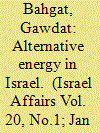

|
|
|
|
|
| Publication |
2014.
|
| Summary/Abstract |
Unlike other countries in the Middle East, Israel has limited hydrocarbon deposits. Since its founding in 1948 Israel has largely relied on foreign supplies to meet almost all its energy needs. In recent years substantial natural gas deposits have been discovered in the Eastern Mediterranean. These discoveries are likely to fundamentally improve the country's energy security. Equally important, Israel has invested massive efforts and resources to utilize the largely untapped solar and wind power. It has also considered initiating a nuclear power programme. Finally, efforts have been made to raise energy efficiency.
|
|
|
|
|
|
|
|
|
|
|
|
|
|
|
|
| 4 |
ID:
098566
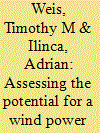

|
|
|
|
|
| Publication |
2010.
|
| Summary/Abstract |
This paper discusses the uptake potential for a wind-diesel production incentive designed specifically for Canadian northern and remote communities. In spite of having over 300 remote communities with extremely high electricity costs, Canada has had little success in developing remote wind energy projects. Most of Canada's large-scale wind power has been developed as a direct result of a Federal production incentive implemented in 2002. Using this incentive structure as a successful model, this paper explores how an incentive tailored to remote wind power could be deployed. Micro-power simulations were done to demonstrate that the production incentive designed by the Canadian Wind Energy Association would cost on average $4.7 $Cdn million and could be expected to result in 14.5 MW of wind energy projects in remote villages in Canada over a 10 year period, saving 11.5 $Cdn million dollars in diesel costs annually, displacing 7600 tonnes of CO2eq emissions and 9.6 million litres of diesel fuel every year.
|
|
|
|
|
|
|
|
|
|
|
|
|
|
|
|
| 5 |
ID:
150443
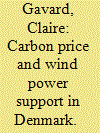

|
|
|
|
|
| Summary/Abstract |
This paper aims at characterizing the conditions of wind power deployment in order to infer a carbon price level that would provide wind power with comparable advantage over fossil fuel technologies as effective wind support policies. The analysis is conducted on Denmark after the electricity market liberalization. Probit and tobit techniques are employed to take account of a potential threshold effect. I find that the level and type of the support policy are the dominant drivers of deployment. A feed-in tariff significantly brings more wind power in than a premium policy. The additional capacity installed monthly increases by more than 1 MW for each additional €/MWh of support. This is compared to the effect of the electricity price, investment cost, interest rate and general economic activity. If the policy is a premium, I find that 23€/MWh of support in addition to electricity price is needed to observe the connection of new turbines to the grid with a 0.5 probability. I convert this support level into a carbon price of 27€/ton if wind power competes with coal, and 48€/t if it competes with gas.
|
|
|
|
|
|
|
|
|
|
|
|
|
|
|
|
| 6 |
ID:
088976


|
|
|
|
|
| Publication |
2009.
|
| Summary/Abstract |
In this paper, several designs of hybrid PV-wind (photovoltaic-wind) systems connected to the electrical grid, including the intermittent production of hydrogen, are shown. The objective considered in the design is economical to maximise the net present value (NPV) of the system.
A control strategy has been applied so that hydrogen is only produced by the electrolyser when there is an excess of electrical energy that cannot be exported to the grid (intermittent production of hydrogen).
Several optimisation studies based on different scenarios have been carried out. After studying the results - for systems with which the produced hydrogen would be sold for external consumption - it can be stated that the selling price of hydrogen should be about 10 €/kg in areas with strong wind, in order to get economically viable systems.
For the hydrogen-producing systems in which hydrogen is produced when there is an excess of electricity and then stored and later used in a fuel cell to produce electricity to be sold to the grid, even in areas with high wind speed rate, the price of electrical energy produced by the fuel cell should be very high for the system to be profitable.
|
|
|
|
|
|
|
|
|
|
|
|
|
|
|
|
| 7 |
ID:
176883
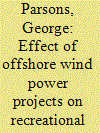

|
|
|
|
|
| Summary/Abstract |
We use contingent-behavior data from a stated-preference survey to estimate the effect of offshore wind power projects on recreational beach use on the East Coast of the United States. The data are from an internet-based probabilistic sample of beachgoers (n = 1725) visiting beaches from Massachusetts to South Carolina in 2015. The contingent-behavior data are based on responses to visual simulations of wind power projects at seven different distances offshore (2.5–20 miles) in clear and hazy conditions and at night. We consider the effect on beach enjoyment/experienceand trips taken to a beach. As expected the nearer the projects are to shore, the greater their negative effect. For example, at 2.5-miles offshore, 29% of the sample state they would not visit the beach compared to only 5% at 20-miles offshore. Offsetting the negative effects, we also find evidence of potentially a large numbers of curiosity trips to view offshore wind power projects.
|
|
|
|
|
|
|
|
|
|
|
|
|
|
|
|
| 8 |
ID:
118055


|
|
|
| 9 |
ID:
114287
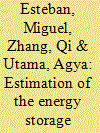

|
|
|
|
|
| Publication |
2012.
|
| Summary/Abstract |
Renewable energy systems are often criticized because of their intermittency and need for substantial amount of backup in terms of other energy sources or storage. The present paper proposes a method to estimate the required amount of storage backup for a mostly solar and wind system that uses also biomass and hydroenergy as minor components of the electricity mix. An hourly simulation was carried out to determine the amount of electricity that could be produced based on the meteorological conditions of year 2001 in Japan, and this was compared with the maximum electricity demands imposed in the system for each month of the year. The system thus proposed has 100% chance of meeting around 40% of the electricity demand between 11:00 and 18:00, and the optimum scenario obtained (a 2:1 mix of solar to wind energy) required around 40 TW of storage to balance the extra electricity demand that occurs during the summer in Japan. It appears unlikely that the batteries in EV in vehicles will be able to meet this storage requirement in the future, though the system is able to adequately meet the electricity demand during the majority of the year, and hence showcases the viability of renewable energy.
|
|
|
|
|
|
|
|
|
|
|
|
|
|
|
|
| 10 |
ID:
188548
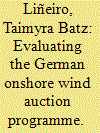

|
|
|
|
|
| Summary/Abstract |
Auctions are a highly demanded policy instrument for the promotion of renewable energy sources. Their flexible structure makes them adaptable to country-specific conditions and needs. However, their success depends greatly on how those needs are operationalised in the design elements. Disaggregating data from the German onshore wind auction programme into individual projects, we evaluated the contribution of auctions to the achievement of their primary (deployment at competitive prices) and secondary (diversity) objectives and have highlighted design elements that affect the policy's success or failure. We have shown that, in the German case, the auction scheme is unable to promote wind deployment at competitive prices, and that the design elements used to promote the secondary objectives not only fall short at achieving their intended goals, but create incentives for large actors to game the system.
|
|
|
|
|
|
|
|
|
|
|
|
|
|
|
|
| 11 |
ID:
109372


|
|
|
|
|
| Publication |
2011.
|
| Summary/Abstract |
This paper seeks to evaluate the effect of the upcoming 2010 UK Feed-in Tariff (UK FIT) on decentralised small wind-energy installations at the household and building level in urban locations. It is projected that the UK FIT will stimulate an unprecedented surge in building-mounted turbine installation. The tariff amount must stimulate incentive but mitigate the likelihood of distortions in the competitive electricity market. To analyse these issues, measured energy output from sites in the Warwick Wind Trials Project (WWTP) is converted into revenue in a net-present-value (NPV) framework for assessing commercial purchases of small wind systems. Variances in project variables are examined through NPV simulations using Monte Carlo analysis to capture permutations of small wind-project performance in the UK-with and without the UK FIT. Our research concludes that the proposed tariff amount of 30.5 p/kWh will not significantly boost the economic attractiveness of mildly selective (WWTP-based) sites in the UK. Furthermore, the fixed-tariff rate (£/kWh generated) could cause inefficiencies applied across uneven wind-resource distribution. The results of this study suggest further examination of policy related to micro-generation, in particular decentralised small wind projects.
|
|
|
|
|
|
|
|
|
|
|
|
|
|
|
|
| 12 |
ID:
183611


|
|
|
|
|
| Summary/Abstract |
What drives inequalities in the uptake of low-carbon energy technologies? Research has shown that people on higher incomes are significantly more likely to access and benefit from policies designed to boost uptake of clean energy technologies than those with lower incomes, revealing a pervasive inequality issue. Yet little is known about how these inequalities evolve or interact with factors beyond income alone, understanding of which is crucial to designing policies which do not simply replicate or exacerbate existing inequalities going forward. This paper thus advances the novel “feed-in-tariff trap” theory, which posits that, rather than income alone, peer diffusion and socioeconomic factors compound to widen inequalities in the uptake of low-carbon technologies over time. Using a combination of mixed effects and piecewise structural equation modelling, this theory is tested on the adoption of 21,206 household-level wind and solar PV installations across 6976 micro-level data-zones in Scotland between 2009 and 2020 under the UK government feed-in-tariff. It finds crucially that: (1) household solar PV and wind are adopted consistently in higher-income areas, (2) peer diffusion is strongest in higher income areas with high early adoption rates, and (3) socioeconomic conditions are extremely temporally stubborn. Combined, this trifecta creates an inequality “trap”, locking the benefits of low-carbon technology subsidies into the same higher income areas and widening the gap in uptake between more affluent and deprived communities as a result. Recommendations are given on how best to address this, with implications for anyone concerned with a “just” transition going forward.
|
|
|
|
|
|
|
|
|
|
|
|
|
|
|
|
| 13 |
ID:
182781
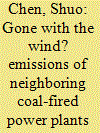

|
|
|
|
|
| Summary/Abstract |
Based on a nationwide representative county-level dataset from China, this article empirically examines the spillover effects of air pollution from neighboring coal-fired power plants on local mortality rates due to cardiovascular and respiratory diseases. We combine data on power plants' industrial output with information on wind direction and speed to proxy for air pollution, and find that air pollution from neighboring power plants indeed has significant negative effects on local public health. The resulting treatment costs are also enormous. Our findings shed light on the necessity of intergovernmental cooperation in environmental governance.
|
|
|
|
|
|
|
|
|
|
|
|
|
|
|
|
| 14 |
ID:
163562
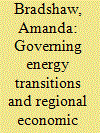

|
|
|
|
|
| Summary/Abstract |
States, regions, and municipalities have a growing importance in innovating policies to promote renewable sources of energy. This article examines the contribution of three state governments in developing and deploying wind and solar energy technologies in Brazil. The Brazilian electricity sector represents an interesting case of a middle-income country that is distinguished by strong federal involvement in energy governance and a reliance on hydroelectric power, followed by natural gas and coal. Using interviews conducted with policymakers and energy professionals, we find that regional energy transitions emerge as part of a process where state-level actors frame renewable energy choices primarily in terms of economic development opportunities and improving energy security. The engagement of regional institutions and organizations with energy priorities further influences the development of renewable technologies. The main policy implication is that state governments can have a strong role in the learning and niche formation of renewable alternatives that have been given less priority at the national level. This paper concludes that future policies should investigate how to scale up state renewable energy programs and initiatives.
|
|
|
|
|
|
|
|
|
|
|
|
|
|
|
|
| 15 |
ID:
103490


|
|
|
|
|
| Publication |
2011.
|
| Summary/Abstract |
We examine the changes to the electric power system required to incorporate high penetration of variable wind and solar electricity generation in a transmission constrained grid. Simulations were performed in the Texas, US (ERCOT) grid where different mixes of wind, solar photovoltaic and concentrating solar power meet up to 80% of the electric demand. The primary constraints on incorporation of these sources at large scale are the limited time coincidence of the resource with normal electricity demand, combined with the limited flexibility of thermal generators to reduce output. An additional constraint in the ERCOT system is the current inability to exchange power with neighboring grids.
By themselves, these constraints would result in unusable renewable generation and increased costs. But a highly flexible system - with must-run baseload generators virtually eliminated - allows for penetrations of up to about 50% variable generation with curtailment rates of less than 10%. For penetration levels up to 80% of the system's electricity demand, keeping curtailments to less than 10% requires a combination of load shifting and storage equal to about one day of average demand.
|
|
|
|
|
|
|
|
|
|
|
|
|
|
|
|
| 16 |
ID:
177440


|
|
|
|
|
| Summary/Abstract |
As global investment in renewable energy technologies continue to trend upward, the effects of variable (intermittent) renewable energy technologies on power markets have created serious challenges for regulators and policymakers. The literature on the effects of these technologies on day-ahead markets has been well established; however, further research is required on intra-day and real-time (balancing) markets to understand how these technologies are changing electricity market dynamics. In this respect, this study aims to assess the effects of the variable renewable energy technologies (wind and run-of-river hydro) on Turkish balancing market prices using quantile regression. In addition, ordered logistic regression is used to evaluate how system imbalances are changing as a result of these technologies. Model results show that system marginal price declines as variable renewable energy generation increases. Moreover, there is a higher probability of positive imbalance as the positive difference between real-time and projected variable renewable energy generation increases. Overall, an increase in variable renewable energy generation implies lower prices, but higher positive imbalances for the system. Hence, we recommend that Turkey should revise its current market design to incorporate the geographical and temporal generation characteristics of these technologies.
|
|
|
|
|
|
|
|
|
|
|
|
|
|
|
|
| 17 |
ID:
169870
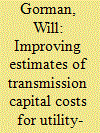

|
|
|
|
|
| Summary/Abstract |
Estimating the overall costs of transmission needed to integrate variable renewable energy (VRE) onto the grid is challenging. An improved understanding of these transmission costs would support electricity system planning as VRE penetrations increase. This paper brackets VRE transmission capital costs using multiple approaches based on interconnection studies, actual transmission projects, capacity-expansion simulation models, and aggregated U.S. VRE-related transmission expenditures. Each approach possesses advantages and drawbacks, and combining the approaches lends confidence to the results. The resulting range of average levelized VRE transmission costs is $1–$10/MWh, which is generally lower than earlier estimates in the literature. These transmission capital costs can increase the direct plant-level levelized cost of VRE by 3%–33%, based on levelized costs of energy of $29–$56/MWh for utility-scale wind and $36–$46/MWh for utility-scale solar. As VRE deployment continues to expand, policy makers can use this information to (1) assess the benefits of transmission avoidance and deferral when comparing distributed energy resources versus utility-scale projects, (2) evaluate the potential costs of large-scale public transmission investments, and (3) better analyze system-level costs of utility-scale VRE technologies. Future research can expand on the framework presented here by providing a review of operation and maintenance costs for transmission systems.
|
|
|
|
|
|
|
|
|
|
|
|
|
|
|
|
| 18 |
ID:
097493
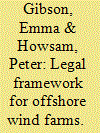

|
|
|
|
|
| Publication |
2010.
|
| Summary/Abstract |
The impact of the legal framework for the consents process on the rate of development of offshore wind farms in England, and the achievement of targets for renewable electricity generation have been reviewed. From the literature and consulted stakeholders it was found that the complexity of the current consents process has adversely affected the rate of development and the achievement of renewable energy targets. Future projects will be subject to a different legal framework for consents, under the Planning Act 2008 and the Marine and Coastal Access Bill. From a comparison of process diagrams for the current and future consents processes, it is concluded that the future process should be an improvement. However, uncertainties remain about the detailed procedures and operation of the future consenting authorities. The capacity and capability of key stakeholders to meet their obligations have implications for the time frame for the processes of applying for, and the granting of, consents. Furthermore improved engagement from developers and clarity about the role of local authorities are essential if progress is to be made. The need for a holistic and strategic view of the industry, including associated development of the supply chain and the transmission grid, is also highlighted.
|
|
|
|
|
|
|
|
|
|
|
|
|
|
|
|
| 19 |
ID:
112245
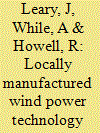

|
|
|
|
|
| Publication |
2012.
|
| Summary/Abstract |
To date, the use of wind power for rural electrification has been limited. However the fact that micro-wind turbines can be manufactured using only basic workshop tools, techniques and materials, and therefore can be produced locally is often overlooked. Local manufacture has the potential to boost the local economy, build local capacity, reduce costs and produce resilient and flexible energy systems. However, locally manufactured technology must be seen as socially embedded due to the variety of local knowledge, skills, equipment and materials needed to construct and maintain such systems, as well as the organisational structures needed to ensure their long term sustainability. Evidence from successful initiatives suggests that stable institutional support from intermediaries such as the local/national government or NGOs is necessary to foster the development of a wind power industry based on local manufacture. The roles of these intermediaries include identifying and targeting windy areas with favourable environmental conditions, conducting research and development, collecting feedback from end users, creating supply chains for new parts and materials and developing relevant knowledge and skills. In this paper, three case studies of specific initiatives are analysed to draw out the social, economic and technical factors that could facilitate wider adoption of the technology.
|
|
|
|
|
|
|
|
|
|
|
|
|
|
|
|
| 20 |
ID:
192622
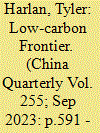

|
|
|
|
|
| Summary/Abstract |
China's west has long been framed as an undeveloped frontier, set apart by poverty and a resource-based economy. Since the 2000s, however, utility-scale renewable energy infrastructure has expanded rapidly in western China, promising local economic benefits tied to national low-carbon transition. This paper contends that these benefits have been precarious and unevenly distributed. I argue that utility-scale renewable energy has remade western China as a “low-carbon frontier,” a resource-rich region that generates low-carbon value for the national green economy. I highlight three features of low-carbon frontiers: they are constructed as spaces of exploitable low-carbon resources, creating an investment boom; they are enclosed through new land arrangements and infrastructure construction, rapidly and with little coordination; and they are reliant on external markets and policy decisions, entrenching dependency. These conditions make it difficult for frontier regions to capture sustained economic development benefits from the boom in the absence of persistent central state supports. I analyse these features by comparing two sets of technologies with similar, but ultimately diverging, trajectories: small and large hydropower in China's south-west, and solar and wind in the north-west.
|
|
|
|
|
|
|
|
|
|
|
|
|
|
|
|
|
|
|
|
|